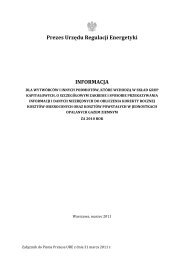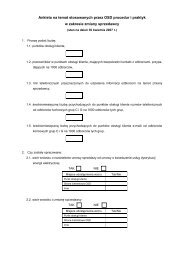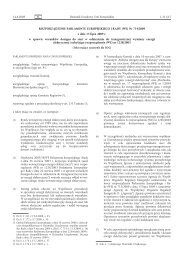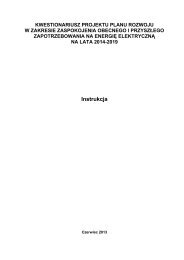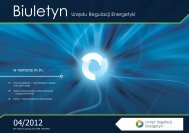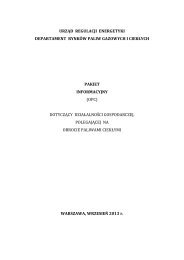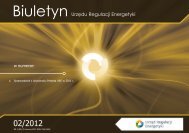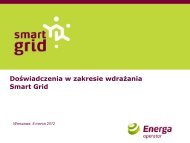Regulation (EU) No 347/2013 of the European ... - EUR-Lex
Regulation (EU) No 347/2013 of the European ... - EUR-Lex
Regulation (EU) No 347/2013 of the European ... - EUR-Lex
You also want an ePaper? Increase the reach of your titles
YUMPU automatically turns print PDFs into web optimized ePapers that Google loves.
EN25.4.<strong>2013</strong> Official Journal <strong>of</strong> <strong>the</strong> <strong>European</strong> Union L 115/61Article 24Entry into forceThis <strong>Regulation</strong> shall enter into force on <strong>the</strong> twentieth day following that <strong>of</strong> its publication in <strong>the</strong> OfficialJournal <strong>of</strong> <strong>the</strong> <strong>European</strong> Union.It shall apply from 1 June <strong>2013</strong> with <strong>the</strong> exception <strong>of</strong> Articles 14 and 15 which shall apply as from <strong>the</strong>date <strong>of</strong> application <strong>of</strong> <strong>the</strong> relevant <strong>Regulation</strong> on a Connecting Europe Facility.This <strong>Regulation</strong> shall be binding in its entirety and directly applicable in all Member States.Done at Strasbourg, 17 April <strong>2013</strong>.For <strong>the</strong> <strong>European</strong> ParliamentThe PresidentM. SCHULZFor <strong>the</strong> CouncilThe PresidentL. CREIGHTON
EN25.4.<strong>2013</strong> Official Journal <strong>of</strong> <strong>the</strong> <strong>European</strong> Union L 115/63Member States concerned: Austria, Bulgaria, Croatia ( 1 ), Czech Republic, Cyprus, France, Germany, Hungary, Greece,Italy, Poland, Romania, Slovakia, Slovenia;(8) Baltic Energy Market Interconnection Plan in gas (‘BEMIP Gas’): gas infrastructure to end <strong>the</strong> isolation <strong>of</strong> <strong>the</strong> threeBaltic States and Finland and <strong>the</strong>ir dependency on a single supplier, to reinforce internal grid infrastructuresaccordingly, and to increase diversification and security <strong>of</strong> supplies in <strong>the</strong> Baltic Sea region.Member States concerned: Denmark, Estonia, Finland, Germany, Latvia, Lithuania, Poland, Sweden.3. PRIORITY OIL CORRIDOR(9) Oil supply connections in Central Eastern Europe (‘OSC’): interoperability <strong>of</strong> <strong>the</strong> oil pipeline network in CentralEastern Europe to increase security <strong>of</strong> supply and reduce environmental risks.Member States concerned: Austria, Croatia ( 1 ), Czech Republic, Germany, Hungary, Poland, Slovakia.4. PRIORITY THEMATIC AREAS(10) Smart grids deployment: adoption <strong>of</strong> smart grid technologies across <strong>the</strong> Union to efficiently integrate <strong>the</strong> behaviourand actions <strong>of</strong> all users connected to <strong>the</strong> electricity network, in particular <strong>the</strong> generation <strong>of</strong> large amounts <strong>of</strong>electricity from renewable or distributed energy sources and demand response by consumers.Member States concerned: all;(11) Electricity highways: first electricity highways by 2020, in view <strong>of</strong> building an electricity highways system across <strong>the</strong>Union that is capable <strong>of</strong>:(a) accommodating ever-increasing wind surplus generation in and around <strong>the</strong> <strong>No</strong>r<strong>the</strong>rn and Baltic Seas andincreasing renewable generation in <strong>the</strong> East and South <strong>of</strong> Europe and also <strong>No</strong>rth Africa;(b) connecting <strong>the</strong>se new generation hubs with major storage capacities in <strong>the</strong> <strong>No</strong>rdic countries, <strong>the</strong> Alps and o<strong>the</strong>rregions with major consumption centres; and(c) coping with an increasingly variable and decentralised electricity supply and flexible electricity demand.Member States concerned: all;(12) Cross-border carbon dioxide network: development <strong>of</strong> carbon dioxide transport infrastructure between MemberStates and with neighbouring third countries in view <strong>of</strong> <strong>the</strong> deployment <strong>of</strong> carbon dioxide capture and storage.Member States concerned: all.( 1 ) Subject to and as <strong>of</strong> <strong>the</strong> date <strong>of</strong> accession <strong>of</strong> Croatia.
ENL 115/64 Official Journal <strong>of</strong> <strong>the</strong> <strong>European</strong> Union 25.4.<strong>2013</strong>ANNEX IIENERGY INFRASTRUCTURE CATEGORIESThe energy infrastructure categories to be developed in order to implement <strong>the</strong> energy infrastructure priorities listed inAnnex I are <strong>the</strong> following:(1) concerning electricity:(a) high-voltage overhead transmission lines, if <strong>the</strong>y have been designed for a voltage <strong>of</strong> 220 kV or more, andunderground and submarine transmission cables, if <strong>the</strong>y have been designed for a voltage <strong>of</strong> 150 kV or more;(b) concerning in particular electricity highways; any physical equipment designed to allow transport <strong>of</strong> electricity on<strong>the</strong> high and extra-high voltage level, in view <strong>of</strong> connecting large amounts <strong>of</strong> electricity generation or storagelocated in one or several Member States or third countries with large-scale electricity consumption in one orseveral o<strong>the</strong>r Member States;(c) electricity storage facilities used for storing electricity on a permanent or temporary basis in above-ground orunderground infrastructure or geological sites, provided <strong>the</strong>y are directly connected to high-voltage transmissionlines designed for a voltage <strong>of</strong> 110 kV or more;(d) any equipment or installation essential for <strong>the</strong> systems defined in (a) to (c) to operate safely, securely andefficiently, including protection, monitoring and control systems at all voltage levels and substations;(e) any equipment or installation, both at transmission and medium voltage distribution level, aiming at two-waydigital communication, real-time or close to real-time, interactive and intelligent monitoring and management <strong>of</strong>electricity generation, transmission, distribution and consumption within an electricity network in view <strong>of</strong>developing a network efficiently integrating <strong>the</strong> behaviour and actions <strong>of</strong> all users connected to it — generators,consumers and those that do both — in order to ensure an economically efficient, sustainable electricity systemwith low losses and high quality and security <strong>of</strong> supply and safety;(2) concerning gas:(a) transmission pipelines for <strong>the</strong> transport <strong>of</strong> natural gas and bio gas that form part <strong>of</strong> a network which mainlycontains high-pressure pipelines, excluding high-pressure pipelines used for upstream or local distribution <strong>of</strong>natural gas;(b) underground storage facilities connected to <strong>the</strong> above-mentioned high-pressure gas pipelines;(c) reception, storage and regasification or decompression facilities for liquefied natural gas (LNG) or compressednatural gas (CNG);(d) any equipment or installation essential for <strong>the</strong> system to operate safely, securely and efficiently or to enable bidirectionalcapacity, including compressor stations;(3) concerning oil:(a) pipelines used to transport crude oil;(b) pumping stations and storage facilities necessary for <strong>the</strong> operation <strong>of</strong> crude oil pipelines;(c) any equipment or installation essential for <strong>the</strong> system in question to operate properly, securely and efficiently,including protection, monitoring and control systems and reverse-flow devices;(4) concerning carbon dioxide:(a) dedicated pipelines, o<strong>the</strong>r than upstream pipeline network, used to transport anthropogenic carbon dioxide frommore than one source, i.e. industrial installations (including power plants) that produce carbon dioxide gas fromcombustion or o<strong>the</strong>r chemical reactions involving fossil or non-fossil carbon-containing compounds, for <strong>the</strong>purpose <strong>of</strong> permanent geological storage <strong>of</strong> carbon dioxide pursuant to Directive 2009/31/EC <strong>of</strong> <strong>the</strong> <strong>European</strong>Parliament and <strong>of</strong> <strong>the</strong> Council ( 1 );(b) facilities for liquefaction and buffer storage <strong>of</strong> carbon dioxide in view <strong>of</strong> its fur<strong>the</strong>r transportation. This does notinclude infrastructure within a geological formation used for <strong>the</strong> permanent geological storage <strong>of</strong> carbon dioxidepursuant to Directive 2009/31/EC and associated surface and injection facilities;(c) any equipment or installation essential for <strong>the</strong> system in question to operate properly, securely and efficiently,including protection, monitoring and control systems.( 1 ) OJ L 140, 5.6.2009, p. 114.
EN25.4.<strong>2013</strong> Official Journal <strong>of</strong> <strong>the</strong> <strong>European</strong> Union L 115/67(8) For proposed oil and carbon dioxide transport projects falling under <strong>the</strong> categories set out in Annex II.3 and 4, <strong>the</strong>Commission shall evaluate <strong>the</strong> application <strong>of</strong> <strong>the</strong> criteria set out in Article 4. For proposed carbon dioxide projectsfalling under <strong>the</strong> category set out in Annex II.4, <strong>the</strong> Commission shall also take into account <strong>the</strong> potential for futureextension to include additional Member States. The Commission shall present its assessment to <strong>the</strong> Group.(9) Each Member State to whose territory a proposed project does not relate, but on which <strong>the</strong> proposed project mayhave a potential net positive impact or a potential significant effect, such as on <strong>the</strong> environment or on <strong>the</strong> operation<strong>of</strong> <strong>the</strong> energy infrastructure on its territory, may present an opinion to <strong>the</strong> Group specifying its concerns.(10) The decision-making body <strong>of</strong> <strong>the</strong> Group shall examine, at <strong>the</strong> request <strong>of</strong> a Member State <strong>of</strong> <strong>the</strong> Group, <strong>the</strong>substantiated reasons presented by a Member State pursuant to Article 3(3) for not approving a project <strong>of</strong>common interest related to its territory.(11) The Group shall meet to examine and rank <strong>the</strong> proposed projects taking into account <strong>the</strong> assessment <strong>of</strong> <strong>the</strong>regulators, or <strong>the</strong> assessment <strong>of</strong> <strong>the</strong> Commission for oil and carbon dioxide transport projects.(12) The draft regional lists <strong>of</strong> proposed projects falling under <strong>the</strong> categories set out in Annex II.1 and 2 drawn up by <strong>the</strong>Groups, toge<strong>the</strong>r with any opinions as specified in point (9), shall be submitted to <strong>the</strong> Agency six months before <strong>the</strong>adoption date <strong>of</strong> <strong>the</strong> Union list. The draft regional lists and <strong>the</strong> accompanying opinions shall be assessed by <strong>the</strong>Agency within three months <strong>of</strong> <strong>the</strong> date <strong>of</strong> receipt. The Agency shall provide an opinion on <strong>the</strong> draft regional lists,in particular on <strong>the</strong> consistent application <strong>of</strong> <strong>the</strong> criteria and <strong>the</strong> cost-benefit analysis across regions. The opinion <strong>of</strong><strong>the</strong> Agency shall be adopted in accordance with <strong>the</strong> procedure referred to in Article 15(1) <strong>of</strong> <strong>Regulation</strong> (EC) <strong>No</strong>713/2009.(13) Within one month <strong>of</strong> <strong>the</strong> date <strong>of</strong> receipt <strong>of</strong> <strong>the</strong> Agency’s opinion, <strong>the</strong> decision-making body <strong>of</strong> each Group shalladopt its final regional list, respecting <strong>the</strong> provisions set out in Article 3(3), based on <strong>the</strong> Groups’ proposal andtaking into account <strong>the</strong> opinion <strong>of</strong> <strong>the</strong> Agency and <strong>the</strong> assessment <strong>of</strong> <strong>the</strong> national regulatory authorities submitted inaccordance with point (7), or <strong>the</strong> assessment <strong>of</strong> <strong>the</strong> Commission for oil and carbon dioxide transport projectsproposed in accordance with point (8). The Groups shall submit <strong>the</strong> final regional lists to <strong>the</strong> Commission, toge<strong>the</strong>rwith any opinions as specified in point (9).(14) If, based on <strong>the</strong> regional lists received, and after having taken into account <strong>the</strong> Agency opinion, <strong>the</strong> total number <strong>of</strong>proposed projects <strong>of</strong> common interest on <strong>the</strong> Union list would exceed a manageable number, <strong>the</strong> Commission shallconsider, after having consulted each Group concerned, not to include in <strong>the</strong> Union list projects that were rankedlowest by <strong>the</strong> Group concerned according to <strong>the</strong> ranking established pursuant to Article 4(4).
ENL 115/68 Official Journal <strong>of</strong> <strong>the</strong> <strong>European</strong> Union 25.4.<strong>2013</strong>ANNEX IVRULES AND INDICATORS CONCERNING CRITERIA FOR PROJECTS OF COMMON INTEREST(1) A project with significant cross-border impact is a project on <strong>the</strong> territory <strong>of</strong> a Member State, which fulfils <strong>the</strong>following conditions:(a) for electricity transmission, <strong>the</strong> project increases <strong>the</strong> grid transfer capacity, or <strong>the</strong> capacity available forcommercial flows, at <strong>the</strong> border <strong>of</strong> that Member State with one or several o<strong>the</strong>r Member States, or at anyo<strong>the</strong>r relevant cross-section <strong>of</strong> <strong>the</strong> same transmission corridor having <strong>the</strong> effect <strong>of</strong> increasing this cross-bordergrid transfer capacity, by at least 500 Megawatt compared to <strong>the</strong> situation without commissioning <strong>of</strong> <strong>the</strong> project;(b) for electricity storage, <strong>the</strong> project provides at least 225 MW installed capacity and has a storage capacity thatallows a net annual electricity generation <strong>of</strong> 250 Gigawatt-hours/year;(c) for gas transmission, <strong>the</strong> project concerns investment in reverse flow capacities or changes <strong>the</strong> capability totransmit gas across <strong>the</strong> borders <strong>of</strong> <strong>the</strong> Member States concerned by at least 10 % compared to <strong>the</strong> situation priorto <strong>the</strong> commissioning <strong>of</strong> <strong>the</strong> project;(d) for gas storage or liquefied/compressed natural gas, <strong>the</strong> project aims at supplying directly or indirectly at least twoMember States or at fulfilling <strong>the</strong> infrastructure standard (N-1 rule) at regional level in accordance with Article 6(3)<strong>of</strong> <strong>Regulation</strong> (<strong>EU</strong>) <strong>No</strong> 994/2010 <strong>of</strong> <strong>the</strong> <strong>European</strong> Parliament and <strong>of</strong> <strong>the</strong> Council ( 1 );(e) for smart grids, <strong>the</strong> project is designed for equipments and installations at high-voltage and medium-voltage leveldesigned for a voltage <strong>of</strong> 10 kV or more. It involves transmission and distribution system operators from at leasttwo Member States, which cover at least 50 000 users that generate or consume electricity or do both in aconsumption area <strong>of</strong> at least 300 Gigawatthours/year, <strong>of</strong> which at least 20 % originate from renewable resourcesthat are variable in nature.(2) Concerning projects falling under <strong>the</strong> categories set out in Annex II.1(a) to (d), <strong>the</strong> criteria listed in Article 4 shall beevaluated as follows:(a) Market integration, competition and system flexibility shall be measured in line with <strong>the</strong> analysis made in <strong>the</strong>latest available Union-wide 10-year network development plan in electricity, notably by:— calculating, for cross-border projects, <strong>the</strong> impact on <strong>the</strong> grid transfer capability in both power flow directions,measured in terms <strong>of</strong> amount <strong>of</strong> power (in megawatt), and <strong>the</strong>ir contribution to reaching <strong>the</strong> minimuminterconnection capacity <strong>of</strong> 10 % installed production capacity or, for projects with significant cross-borderimpact, <strong>the</strong> impact on grid transfer capability at borders between relevant Member States, between relevantMember States and third countries or within relevant Member States and on demand-supply balancing andnetwork operations in relevant Member States,— assessing <strong>the</strong> impact, for <strong>the</strong> area <strong>of</strong> analysis as defined in Annex V.10, in terms <strong>of</strong> energy system-widegeneration and transmission costs and evolution and convergence <strong>of</strong> market prices provided by a projectunder different planning scenarios, notably taking into account <strong>the</strong> variations induced on <strong>the</strong> merit order.(b) Transmission <strong>of</strong> renewable energy generation to major consumption centres and storage sites shall be measured inline with <strong>the</strong> analysis made in <strong>the</strong> latest available 10-year network development plan in electricity, notably by:— for electricity transmission, by estimating <strong>the</strong> amount <strong>of</strong> generation capacity from renewable energy sources(by technology, in megawatts), which is connected and transmitted due to <strong>the</strong> project, compared to <strong>the</strong>amount <strong>of</strong> planned total generation capacity from <strong>the</strong>se types <strong>of</strong> renewable energy sources in <strong>the</strong>concerned Member State in 2020 according to <strong>the</strong> national renewable energy action plans as defined inArticle 4 <strong>of</strong> Directive 2009/28/EC,( 1 ) OJ L 295, 12.11.2010, p. 1.
EN25.4.<strong>2013</strong> Official Journal <strong>of</strong> <strong>the</strong> <strong>European</strong> Union L 115/69— for electricity storage, by comparing new capacity provided by <strong>the</strong> project with total existing capacity for <strong>the</strong>same storage technology in <strong>the</strong> area <strong>of</strong> analysis as defined in Annex V.10.(c) Security <strong>of</strong> supply, interoperability and secure system operation shall be measured in line with <strong>the</strong> analysis madein <strong>the</strong> latest available 10-year network development plan in electricity, notably by assessing <strong>the</strong> impact <strong>of</strong> <strong>the</strong>project on <strong>the</strong> loss <strong>of</strong> load expectation for <strong>the</strong> area <strong>of</strong> analysis as defined in Annex V.10 in terms <strong>of</strong> generationand transmission adequacy for a set <strong>of</strong> characteristic load periods, taking into account expected changes inclimate-related extreme wea<strong>the</strong>r events and <strong>the</strong>ir impact on infrastructure resilience. Where applicable, <strong>the</strong>impact <strong>of</strong> <strong>the</strong> project on independent and reliable control <strong>of</strong> system operation and services shall be measured.(3) Concerning projects falling under <strong>the</strong> categories set out in Annex II.2, <strong>the</strong> criteria listed in Article 4 shall be evaluatedas follows:(a) Market integration and interoperability shall be measured by calculating <strong>the</strong> additional value <strong>of</strong> <strong>the</strong> project to <strong>the</strong>integration <strong>of</strong> market areas and price convergence, to <strong>the</strong> overall flexibility <strong>of</strong> <strong>the</strong> system, including <strong>the</strong> capacitylevel <strong>of</strong>fered for reverse flows under various scenarios.(b) Competition shall be measured on <strong>the</strong> basis <strong>of</strong> diversification, including <strong>the</strong> facilitation <strong>of</strong> access to indigenoussources <strong>of</strong> supply, taking into account, successively: diversification <strong>of</strong> sources; diversification <strong>of</strong> counterparts;diversification <strong>of</strong> routes; <strong>the</strong> impact <strong>of</strong> new capacity on <strong>the</strong> Herfindahl-Hirschmann index (HHI)calculated atcapacity level for <strong>the</strong> area <strong>of</strong> analysis as defined in Annex V.10.(c) Security <strong>of</strong> gas supply shall be measured by calculating <strong>the</strong> additional value <strong>of</strong> <strong>the</strong> project to <strong>the</strong> short and longtermresilience <strong>of</strong> <strong>the</strong> Union’s gas system and to enhancing <strong>the</strong> remaining flexibility <strong>of</strong> <strong>the</strong> system to cope withsupply disruptions to Member States under various scenarios as well as <strong>the</strong> additional capacity provided by <strong>the</strong>project measured in relation to <strong>the</strong> infrastructure standard (N-1 rule) at regional level in accordance withArticle 6(3) <strong>of</strong> <strong>Regulation</strong> (<strong>EU</strong>) <strong>No</strong> 994/2010.(d) Sustainability shall be measured as <strong>the</strong> contribution <strong>of</strong> a project to reduce emissions, to support <strong>the</strong> back-up <strong>of</strong>renewable electricity generation or power-to-gas and biogas transportation, taking into account expected changesin climatic conditions.(4) Concerning projects falling under <strong>the</strong> category set out in Annex II.1(e), each function listed in Article 4 shall beevaluated against <strong>the</strong> following criteria:(a) Level <strong>of</strong> sustainability: This criterion shall be measured by assessing <strong>the</strong> reduction <strong>of</strong> greenhouse gas emissions,and <strong>the</strong> environmental impact <strong>of</strong> electricity grid infrastructure.(b) Capacity <strong>of</strong> transmission and distribution grids to connect and bring electricity from and to users: This criterionshall be measured by estimating <strong>the</strong> installed capacity <strong>of</strong> distributed energy resources in distribution networks, <strong>the</strong>allowable maximum injection <strong>of</strong> electricity without congestion risks in transmission networks, and <strong>the</strong> energy notwithdrawn from renewable sources due to congestion or security risks.(c) Network connectivity and access to all categories <strong>of</strong> network users: This criterion shall be measured by assessing<strong>the</strong> methods adopted to calculate charges and tariffs, as well as <strong>the</strong>ir structure, for generators, consumers andthose that do both, and <strong>the</strong> operational flexibility provided for dynamic balancing <strong>of</strong> electricity in <strong>the</strong> network.(d) Security and quality <strong>of</strong> supply: This criterion shall be measured by assessing <strong>the</strong> ratio <strong>of</strong> reliably availablegeneration capacity and peak demand, <strong>the</strong> share <strong>of</strong> electricity generated from renewable sources, <strong>the</strong> stability<strong>of</strong> <strong>the</strong> electricity system, <strong>the</strong> duration and frequency <strong>of</strong> interruptions per customer, including climate relateddisruptions, and <strong>the</strong> voltage quality performance.
EN25.4.<strong>2013</strong> Official Journal <strong>of</strong> <strong>the</strong> <strong>European</strong> Union L 115/71ANNEX VENERGY SYSTEM-WIDE COST-BENEFIT ANALYSISThe methodology for a harmonised energy system-wide cost-benefit analysis for projects <strong>of</strong> common interest shall satisfy<strong>the</strong> following principles laid down in this Annex.(1) The methodology shall be based on a common input data set representing <strong>the</strong> Union’s electricity and gas systems in<strong>the</strong> years n+5, n+10, n+15, and n+20, where n is <strong>the</strong> year in which <strong>the</strong> analysis is performed. This data set shallcomprise at least:(a) in electricity: scenarios for demand, generation capacities by fuel type (biomass, geo<strong>the</strong>rmal, hydro, gas, nuclear,oil, solid fuels, wind, solar photovoltaic, concentrated solar, o<strong>the</strong>r renewable technologies) and <strong>the</strong>ir geographicallocation, fuel prices (including biomass, coal, gas and oil), carbon dioxide prices, <strong>the</strong> composition <strong>of</strong> <strong>the</strong>transmission and, if relevant, <strong>the</strong> distribution network, and its evolution, taking into account all new significantgeneration (including capacity equipped for capturing carbon dioxide), storage and transmission projects forwhich a final investment decision has been taken and that are due to be commissioned by <strong>the</strong> end <strong>of</strong> year n+5;(b) in gas: scenarios for demand, imports, fuel prices (including coal, gas and oil), carbon dioxide prices, <strong>the</strong>composition <strong>of</strong> <strong>the</strong> transmission network and its evolution, taking into account all new projects for which afinal investment decision has been taken and that are due to be commissioned by <strong>the</strong> end <strong>of</strong> year n+5.(2) The data set shall reflect Union and national law in force at <strong>the</strong> date <strong>of</strong> analysis. The data sets used for electricity andgas respectively shall be compatible, notably with regard to assumptions on prices and volumes in each market. Thedata set shall be elaborated after formally consulting Member States and <strong>the</strong> organisations representing all relevantstakeholders. The Commission and <strong>the</strong> Agency shall ensure access to <strong>the</strong> required commercial data from thirdparties when applicable.(3) The methodology shall give guidance for <strong>the</strong> development and use <strong>of</strong> network and market modelling necessary for<strong>the</strong> cost- benefit analysis.(4) The cost-benefit analysis shall be based on a harmonised evaluation <strong>of</strong> costs and benefits for <strong>the</strong> different categories<strong>of</strong> projects analysed and cover at least <strong>the</strong> period <strong>of</strong> time referred to in point (1).(5) The cost-benefit analysis shall at least take into account <strong>the</strong> following costs: capital expenditure, operational andmaintenance expenditure over <strong>the</strong> technical lifecycle <strong>of</strong> <strong>the</strong> project and decommissioning and waste managementcosts, where relevant. The methodology shall give guidance on discount rates to be used for <strong>the</strong> calculations.(6) For electricity transmission and storage, <strong>the</strong> cost-benefit analysis shall at least take into account <strong>the</strong> impact andcompensations resulting from <strong>the</strong> application <strong>of</strong> Article 13 <strong>of</strong> <strong>Regulation</strong> (EC) <strong>No</strong> 714/2009, <strong>the</strong> impacts on <strong>the</strong>indicators defined in Annex IV, and <strong>the</strong> following impacts:(a) greenhouse gas emissions and transmission losses over <strong>the</strong> technical lifecycle <strong>of</strong> <strong>the</strong> project;(b) future costs for new generation and transmission investment over <strong>the</strong> technical lifecycle <strong>of</strong> <strong>the</strong> project;(c) operational flexibility, including optimisation <strong>of</strong> regulating power and ancillary services;(d) system resilience, including disaster and climate resilience, and system security, notably for <strong>European</strong> criticalinfrastructures as defined in Directive 2008/114/EC.
ENL 115/72 Official Journal <strong>of</strong> <strong>the</strong> <strong>European</strong> Union 25.4.<strong>2013</strong>(7) For gas, <strong>the</strong> cost-benefit analysis shall at least take into account <strong>the</strong> results <strong>of</strong> market testing <strong>the</strong> impacts on <strong>the</strong>indicators defined in Annex IV and <strong>the</strong> following impacts:(a) disaster and climate resilience, and system security, notably for <strong>European</strong> critical infrastructures as defined inDirective 2008/114/EC;(b) congestion in <strong>the</strong> gas network.(8) For smart grids, <strong>the</strong> cost-benefit analysis shall take into account <strong>the</strong> impacts on <strong>the</strong> indicators defined in Annex IV.(9) The detailed method used to take into account <strong>the</strong> indicators referred to in points 6 to 8 shall be elaborated afterformally consulting Member States and <strong>the</strong> organisations representing all relevant stakeholders.(10) The methodology shall define <strong>the</strong> analysis to be carried out, based on <strong>the</strong> relevant input data set, by determining <strong>the</strong>impacts with and without each project. The area for <strong>the</strong> analysis <strong>of</strong> an individual project shall cover all MemberStates and third countries, on whose territory <strong>the</strong> project shall be built, all directly neighbouring Member States andall o<strong>the</strong>r Member States significantly impacted by <strong>the</strong> project.(11) The analysis shall identify <strong>the</strong> Member States on which <strong>the</strong> project has net positive impacts (beneficiaries) and thoseMember States on which <strong>the</strong> project has a net negative impact (cost bearers). Each cost-benefit analysis shall includesensitivity analyses concerning <strong>the</strong> input data set, <strong>the</strong> commissioning date <strong>of</strong> different projects in <strong>the</strong> same area <strong>of</strong>analysis and o<strong>the</strong>r relevant parameters.(12) Transmission, storage system and compressed and liquefied natural gas terminal operators and distribution systemoperators shall exchange <strong>the</strong> information necessary for <strong>the</strong> elaboration <strong>of</strong> <strong>the</strong> methodology, including <strong>the</strong> relevantnetwork and market modelling. Any transmission or distribution system operator collecting information on behalf<strong>of</strong> o<strong>the</strong>r transmission or distribution system operators shall give back to <strong>the</strong> participating transmission anddistribution system operators <strong>the</strong> results <strong>of</strong> <strong>the</strong> collection <strong>of</strong> data.(13) For <strong>the</strong> common electricity and gas market and network model set out in paragraph 8 <strong>of</strong> Article 11, <strong>the</strong> input dataset referred to in point (1) shall cover <strong>the</strong> years n+10, n+20 and n+30 and <strong>the</strong> model shall allow for a fullassessment <strong>of</strong> economic, social and environmental impacts, notably including external costs such as those relatedto greenhouse gas and conventional air pollutant emissions or security <strong>of</strong> supply.
ENL 115/74 Official Journal <strong>of</strong> <strong>the</strong> <strong>European</strong> Union 25.4.<strong>2013</strong>(5) In <strong>the</strong> context <strong>of</strong> <strong>the</strong> public consultation to be carried out before submission <strong>of</strong> <strong>the</strong> application file, <strong>the</strong> relevantparties shall at least:(a) publish an information leaflet <strong>of</strong> no more than 15 pages, giving, in a clear and concise manner, an overview <strong>of</strong><strong>the</strong> purpose and preliminary timetable <strong>of</strong> <strong>the</strong> project, <strong>the</strong> national grid development plan, alternative routesconsidered, expected impacts, including <strong>of</strong> cross-border nature, and possible mitigation measures, which shallbe published prior to <strong>the</strong> start <strong>of</strong> <strong>the</strong> consultation; The information leaflet shall fur<strong>the</strong>rmore list <strong>the</strong> web addresses<strong>of</strong> <strong>the</strong> transparency platform referred to in Article 18 and <strong>of</strong> <strong>the</strong> manual <strong>of</strong> procedures referred to in point (1);(b) inform all stakeholders affected about <strong>the</strong> project through <strong>the</strong> website referred to in Article 9(7) and o<strong>the</strong>rappropriate information means;(c) invite in written form relevant affected stakeholders to dedicated meetings, during which concerns shall bediscussed.(6) The project website shall make available as a minimum <strong>the</strong> following:(a) <strong>the</strong> information leaflet referred to in point (5);(b) a non-technical and regularly updated summary <strong>of</strong> no more than 50 pages reflecting <strong>the</strong> current status <strong>of</strong> <strong>the</strong>project and clearly indicating, in case <strong>of</strong> updates, changes to previous versions;(c) <strong>the</strong> project and public consultation planning, clearly indicating dates and locations for public consultations andhearings and <strong>the</strong> envisaged subject matters relevant for those hearings;(d) contact details in view <strong>of</strong> obtaining <strong>the</strong> full set <strong>of</strong> application documents;(e) contact details in view <strong>of</strong> conveying comments and objections during public consultations.
EN25.4.<strong>2013</strong> Official Journal <strong>of</strong> <strong>the</strong> <strong>European</strong> Union L 115/75Statement by <strong>the</strong> <strong>European</strong> Commission as regards <strong>the</strong> eligibility <strong>of</strong> projects <strong>of</strong> common interest for<strong>EU</strong> financial assistance in <strong>the</strong> context <strong>of</strong> trans-<strong>European</strong> energy infrastructures (Chapter V <strong>of</strong><strong>Regulation</strong> (<strong>EU</strong>) <strong>No</strong> <strong>347</strong>/<strong>2013</strong> <strong>of</strong> <strong>the</strong> <strong>European</strong> Parliament and <strong>of</strong> <strong>the</strong> Council ( 1 ))The Commission underlines that it considers important that <strong>the</strong> support from <strong>EU</strong> and national sourcesextends to grants for works to enable <strong>the</strong> implementation <strong>of</strong> projects <strong>of</strong> common interest enhancing <strong>the</strong>diversification <strong>of</strong> energy supply sources, routes and counterparts. The Commission reserves <strong>the</strong> right tomake proposals in this direction based on <strong>the</strong> experience gained from <strong>the</strong> monitoring <strong>of</strong> <strong>the</strong> implementation<strong>of</strong> projects <strong>of</strong> common interest in <strong>the</strong> context <strong>of</strong> <strong>the</strong> report foreseen in Article 17 <strong>of</strong> <strong>the</strong> <strong>Regulation</strong> onguidelines for trans-<strong>European</strong> energy infrastructures.( 1 ) See page 39 <strong>of</strong> this Official Journal.



